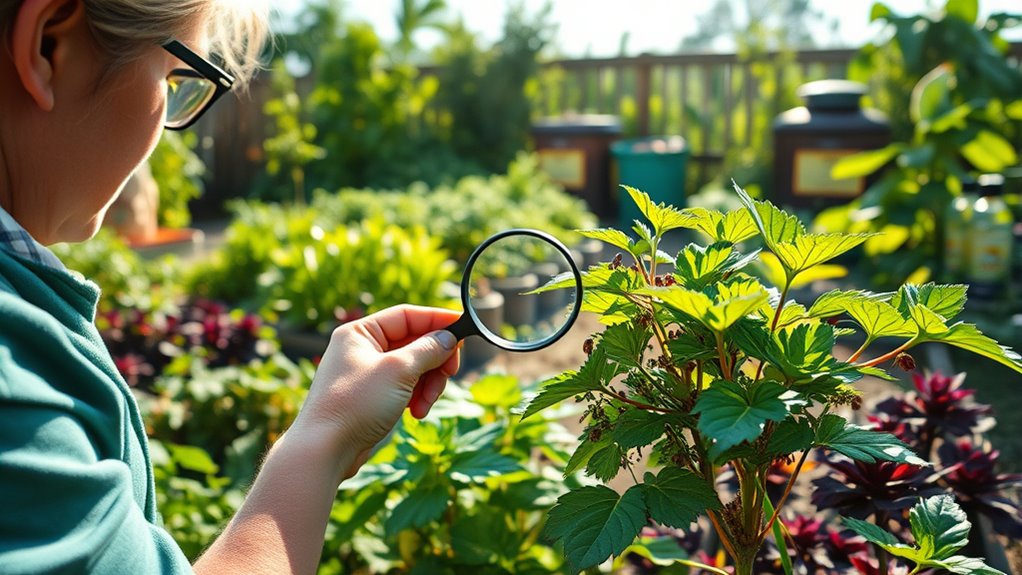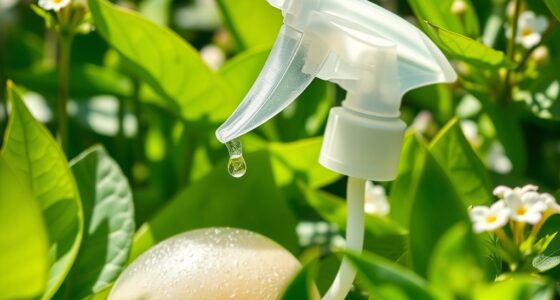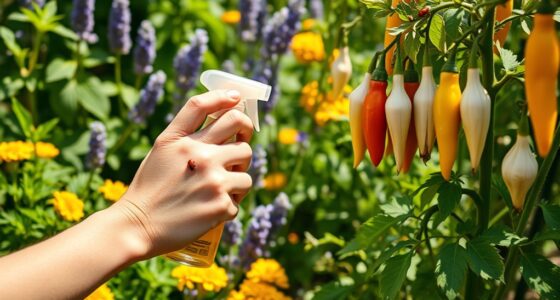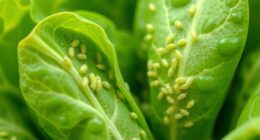Integrated Pest Management (IPM) is a smart way to control pests by combining different methods that are safe for your garden and the environment. You use tools like natural predators, pest monitoring, and cultural practices to keep pest numbers low without over-relying on chemicals. By understanding pest behavior and applying timely, targeted actions, you can maintain a healthy garden. Keep exploring to discover how these strategies work together for successful pest management.
Key Takeaways
- IPM combines biological, cultural, and mechanical methods to control pests with minimal chemical use.
- It emphasizes regular monitoring to detect pests early and assess population levels.
- Biological controls like beneficial insects are used to naturally suppress pest populations.
- Control methods are applied based on pest thresholds to prevent damage while reducing chemicals.
- IPM promotes sustainable gardening by maintaining ecosystem balance and environmental safety.

If you’re looking for an effective way to control pests in your garden without relying solely on chemicals, integrated pest management (IPM) offers a smart and sustainable solution. IPM focuses on combining different strategies to manage pests with minimal environmental impact. One of its core components is biological controls, which involve using natural predators, parasites, or pathogens to keep pest populations in check. You might introduce ladybugs to control aphids or deploy parasitic wasps to target specific pests. These beneficial organisms work naturally, reducing your need for chemical pesticides and helping maintain a balanced garden ecosystem.
Another essential aspect of IPM is pest monitoring. Regularly inspecting your plants allows you to identify pest problems early before they become overwhelming. Pest monitoring involves checking for signs of damage, identifying which pests are present, and evaluating their population levels. This way, you can determine whether intervention is necessary and choose the most appropriate control method. Monitoring also helps you understand pest cycles and how environmental conditions influence their activity, enabling more precise and targeted actions.
Regular pest monitoring helps identify problems early and guides effective, eco-friendly control strategies.
Once you’ve identified a pest problem through monitoring, the next step in IPM is to examine the severity and decide on a control method. If pest levels are low and unlikely to cause significant damage, you might opt for non-chemical measures like introducing biological controls or manually removing pests. When pest populations are higher, targeted interventions such as organic pesticides or cultural practices—like crop rotation or adjusting watering schedules—may be appropriate. The goal is to keep pest populations below economic thresholds, preventing damage while avoiding unnecessary chemical use.
Implementing biological controls can be highly effective and eco-friendly, but it requires patience and proper timing. Introducing natural enemies early in the pest life cycle can prevent outbreaks. Meanwhile, pest monitoring ensures you catch problems early, making biological controls more successful. By continuously observing your garden and understanding pest behavior, you can make informed decisions that align with sustainable gardening principles. Understanding regulatory guidelines and compliance is also crucial when implementing certain control methods, ensuring you stay within legal parameters and promote environmental safety. This proactive approach minimizes risks to beneficial insects, pollinators, and other non-target organisms, promoting a healthier garden environment.
In essence, integrated pest management is a strategic approach that combines biological controls, vigilant pest monitoring, and other practices to keep pests at manageable levels. It empowers you to protect your garden naturally and sustainably, reducing reliance on chemical solutions. By staying attentive and implementing these methods thoughtfully, you create a resilient garden that thrives while being mindful of the environment.
Frequently Asked Questions
How Does IPM Differ From Traditional Pest Control Methods?
Compared to traditional pest control, IPM minimizes chemical reliance by focusing on sustainable methods. Instead of seeking immediate results with heavy pesticide use, you monitor pest levels and target problems with least-toxic solutions first. This approach reduces environmental impact and pest resistance. You’re proactive rather than reactive, combining cultural, biological, and mechanical strategies for long-term control, making IPM a smarter, safer choice over quick-fix chemical treatments.
Can IPM Be Used Effectively in Organic Gardening?
Think of IPM as a well-tuned orchestra, harmonizing sustainable practices and organic methods to control pests effectively. Yes, you can use IPM in organic gardening, because it emphasizes natural solutions like beneficial insects, crop rotation, and organic treatments. This approach allows you to manage pests responsibly, reducing chemical reliance and promoting a healthier garden ecosystem, turning pest control into a symphony of sustainable practices.
What Are the Initial Costs Associated With Implementing IPM?
When considering initial costs for IPM, you should do a thorough cost analysis to understand the expenses involved. While some tools like traps or monitoring devices may require upfront investment, they can reduce long-term pesticide use. Budget considerations include training, equipment, and potential consultation fees. Overall, investing early in IPM can save you money over time by preventing extensive pest damage and reducing chemical costs, making it a smart choice for your garden.
How Long Does It Typically Take to See Results With IPM?
Imagine your garden’s pests suddenly diminish after a few weeks—this is typical with IPM. Results depend on the pest cycle and weather influence; sometimes, you see quick improvements, like with aphids, within 2-4 weeks. Other times, it takes longer, especially if pests are in their egg stage or weather favors their growth. Patience and consistent management help you see steady progress over time.
Are There Specific Pests Where IPM Is Less Effective?
You might find that IPM is less effective against pests with high resistance, like certain aphids or beetles, which can quickly develop pest resistance despite your efforts. When pests stay below economic thresholds, IPM strategies may seem less impactful because the damage isn’t severe enough to justify intervention. In such cases, you may need to combine IPM with other methods or monitor pests closely to prevent resistance build-up and maintain control.
Conclusion
As you embrace integrated pest management, you’ll notice your garden thriving peacefully, like a well-tended oasis. Coincidentally, just as the gentle breeze balances the scent of blooming flowers, your mindful approach balances pest control with nature’s harmony. By combining natural methods and smart practices, you’ll create a garden where pests are kept in check and beauty flourishes. With patience and care, you’ll see your garden flourish, a perfect reflection of your sustainable, eco-friendly efforts.









